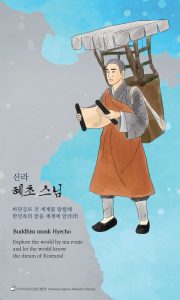 French scholar Paul Pelliot discovered a 1,200-yearold scroll in 1908 at the Mogao Caves in Dunhuang at the crossroads of China and Arabia. It turned out to be a travelogue titled “Wangocheonchukgukjeon” or Memoir of the Pilgrimage to the Five Kingdoms of India. It was written by Hyecho, a Buddhist monk of Silla, who travelled by ship to India in the eighth century. It is Korea’s earliest extant overseas travelogue. It has outstanding universal value as one of the four classic travelogues, along with the Travels of Marco Polo, the Travels of Friar Odoric, and the Travels of Ibn Battuta. How was the author of the scroll found in China proven to be Korean? It was because of a poem he wrote in the travelogue, expressing his nostalgiafor his homeland: “Who can deliver my news to my home Gyerim (another name for Silla)?”
French scholar Paul Pelliot discovered a 1,200-yearold scroll in 1908 at the Mogao Caves in Dunhuang at the crossroads of China and Arabia. It turned out to be a travelogue titled “Wangocheonchukgukjeon” or Memoir of the Pilgrimage to the Five Kingdoms of India. It was written by Hyecho, a Buddhist monk of Silla, who travelled by ship to India in the eighth century. It is Korea’s earliest extant overseas travelogue. It has outstanding universal value as one of the four classic travelogues, along with the Travels of Marco Polo, the Travels of Friar Odoric, and the Travels of Ibn Battuta. How was the author of the scroll found in China proven to be Korean? It was because of a poem he wrote in the travelogue, expressing his nostalgiafor his homeland: “Who can deliver my news to my home Gyerim (another name for Silla)?”
Hyecho is the first known Korean who traveled across the ocean to India, Arabia, and Central Asia. While he was an international traveler, he was also a Korean
with a deep love and longing for his homeland. Hyecho left Silla to Tang China at age 16. He went to Xi’an, the capital of Tang, and to Guangzhou, which had a main international seaport. From Guangzhou, he traveled to India, Persia, and Central Asia. At the time, a voyage to India was a dangerous and life-risking
journey. He overcame his fear of death and took the risk because he was determined to expand his knowledge by exploring different cultures and histories.
Hyecho was the first Korean overseas travel writer and a global citizen who was ahead of his time.